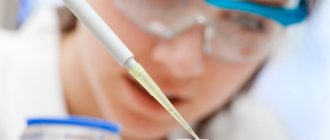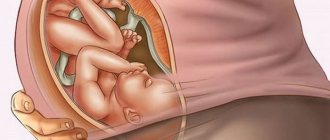HDL, or high-density lipoprotein, is a class of complex proteins that play an important role in removing cholesterol from cells to the liver. In this organ it is converted into bile acids, and then excreted along with feces. This fraction of cholesterol is called “useful” because it reduces the risk of developing cardiovascular diseases.
The norm for women by age is higher than for men. Exceeding this value is considered a favorable factor, but in some cases it may indicate the presence of liver pathologies.
HDL (HDL) - what is it in a biochemical blood test?
HDL / HDL (or High-Density Lipoproteins) are micro/particles in the blood plasma (8-11 nm in size), mainly consisting of proteins and lipids (fats). Their main function is to “transport” excess cholesterol from peripheral tissues to the liver (through the bloodstream) for “utilization” (and removal from the body through the gastrointestinal tract).
HDL structure: apolipoproteins A1 (67%), proteins (45-55%), phospholipids (27-30%), triglycerides (3-7%), cholesterol (17-22%). Initially (after creation in the liver) it takes the form of a disk, as indicated in the topmost image.
That is why HDL cholesterol is usually called “good” cholesterol, because High-density lipoproteins (being the densest, smallest and fastest particles in the blood) have anti-atherogenic properties, taking away excess – conditionally “bad” cholesterol, i.e. LDL cholesterol (Low Density Lipoprotein).
The latter, in fact, is also useful for our lives, dangerous - an EXCESS of it!
High levels of “bad” cholesterol are usually associated with increased risks of developing atherosclerosis
and a number of cardiovascular diseases.
Penetrating into the walls of blood vessels (see VIDEO
below), micro/particles of LDL can be deposited there (over and over again), thereby forming “slides”, which are commonly called “cholesterol plaques”. Over time, the “slides” become higher and larger, blocking the gaps in the vessels. Up to complete blockage (obturation). And this is fraught with a heart attack, stroke or gangrene (of the limbs).
What is cholesterol

What causes blood cholesterol to increase in women?
The reasons for increasing cholesterol levels may be one of the diseases listed below. Having diagnosed yourself with a disease, you can undergo a course of treatment under the guidance of a doctor and eliminate the cause of the increase. What kind of diseases are these?
- First of all, it is necessary to note hereditary diseases:
- combined hyperlipidemia
- polygenic hypercholesterolemia
- hereditary dysbetalipoproteinemia
- Other metabolic disorders may occur against the background of:
- cirrhosis of the liver,
- pancreatic tumors,
- pancreatitis in acute and chronic forms,
- hepatitis of various origins
- hypothyroidism,
- diabetes
- nephroptosis,
- chronic kidney failure,
- hypertension.
The relationship between cholesterol and glucose in the blood
Please note that metabolism, carbohydrates and fats are very interconnected. High levels of cholesterol are found in people with diabetes.
Abuse of sweets and sugar leads to an increased increase in body fat mass and excess weight. Excess body weight is a common cause of diabetes in women. As a result of metabolic disorders, primarily the blood vessels suffer, plaques form, and atherosclerosis develops.
Medical research has revealed a pattern between sugar and cholesterol. All patients with type 2 diabetes mellitus usually have a medical history of high blood pressure (BP) or high cholesterol levels in the blood. Blood pressure can also increase as a result of high cholesterol levels, and there is a risk of developing cardiovascular diseases.
The level of cholesterol and blood sugar in women depends on age. Check your blood glucose levels!
For patients with heart disease, monitoring LDL levels and triglycerides is very important.
Diabetes mellitus disrupts the balance between bad and good cholesterol. For patients with diabetes mellitus it is typical:
- Diabetics often have damaged blood vessels, which is why they often have high concentrations of harmful LDL cholesterol.
- High concentrations of glucose in the blood lead to a persistent increase in LDL cholesterol in the blood for a long time
- Diabetics have lower HDL levels and high levels of triglycerides in the blood, which increases the risk of atherosclerosis and cardiovascular disease.
- Blood supply to the extremities is impaired and blood vessels are blocked, which provokes various diseases of the legs and arms.
Such patients need to pay special attention to their lifestyle, in particular, exercise, go on a diet, balance their menu with varied, healthy foods, and not just fast foods and burgers. Reconsider your eating habits at night, and quit smoking and abusing alcoholic beverages. Eat more fish, fatty fish and seafood significantly reduce LDL (bad cholesterol) levels.
When is it necessary to know the amount of HDL in the blood?
As a rule, the level of high-density lipoprotein (HDL) in the blood plasma is determined using a LIPIDOGRAM
. That is, a special biochemical (complex) blood test that helps identify virtually all unhealthy lipid levels, which is very important for doctors to know - to assess the risks of developing cardiovascular diseases (CVD), and prescribe adequate treatment to the patient. At the same time, depending on what these levels are: borderline or already dangerous?
Other components of the lipid profile (except HDL cholesterol) are: total cholesterol (or total cholesterol), LDL cholesterol (low density lipoproteins) and TRIGLYCERIDES (TG)
.
As mentioned above, it is HDL cholesterol that is useful and good, because it removes excess conditional / “bad” cholesterol in the blood, “transporting” it back to the liver. Consequently, an insufficient amount of it in the blood plasma is fraught with negative consequences, and normalization (on the contrary) leads to recovery. That is why doctors prescribe such tests - both to identify the problem and to monitor the effectiveness of treatment (with a special diet, a health-improving set of physical exercises, or taking lipid-lowering medications).
In the future, the medical professional may need to separately - only the values of total cholesterol (TC) and good (i.e. HDL cholesterol / HDL-C). Necessary for calculating the COEFFICIENT (INDEX) OF ATHEROGENICITY
(by the way, it can be calculated
ONLINE
on our website). But first you will always be prescribed a comprehensive blood test (i.e., full lipid spectrum). Especially if the history reveals so-called risk factors (according to the recommendations of the NCEP / National Cholesterol Education Program committee of 2002). The most important of which (for adult men and women) will usually include:
- nicotine addiction (or even “indulgence” in smoking);
- obesity (or overweight problems / with a BMI over 25
/
ONLINE BMI CALCULATOR
); - unhealthy (harmful/fatty) diet;
- physical inactivity (little/active lifestyle, possibly due to “sedentary” work);
- age limits (men are over 45 years old, and women are over 55 years old);
- hypertension (high blood pressure - from 140/90 mm Hg and above);
- family history of premature CVD (that is, cardiovascular disease in close “blood” relatives: men under the age of 55 years, women under the age of 65);
- the presence of cardiovascular disease syndromes, as well as a previous heart attack;
- diabetes or pre/diabetes.
For teenagers and children
A comprehensive blood test that determines fat/lipid levels is necessary not only for adults, but also for children. According to the recommendations of the American Academy of Pediatrics, children should be tested for preventive purposes: the first time - between the ages of 9 and 11 years, and again - between the ages of 17 and 21 years.
As is the case with adults (or the elderly), children or adolescents (especially if there are risk factors) may also need additional blood testing (i.e., more frequent testing). The most important risk factors include: a family history of CVD (cardiovascular disease), and if their blood relatives suffer from diabetes, hypertension and obesity.
In addition, medical professionals can prescribe a lipid profile even for a child under the age of 9 if his parents have problems with high cholesterol levels. However, a lipid profile is never prescribed for children under 2 years of age!
For monitoring purposes (observation of treatment)
A blood test to determine the level of HDL “good” cholesterol can be prescribed by doctors - regularly, i.e. at certain intervals. And, first of all, this is necessary to assess the effectiveness of certain lifestyle changes, such as a “low-fat” diet, a set of physical exercises and, of course, a complete cessation of smoking. According to the recommendations of foreign experts (“American College of Cardiology” / “American Heart Association”), adults taking statins must undergo a lipid profile (on an empty stomach) 4-12 weeks after starting to take medications. And then - every 3-12 months, because... Healthcare professionals should make sure these medications are working properly.

general characteristics
Patients are often interested in the question: what is cholesterol and why is it needed in our body? This is a molecule of complex fat, more than 80% of which is synthesized in the human body by liver cells, the rest comes with food. Beneficial properties of cholesterol:
- increases the density of the cytoplasmic membrane of cells;
- takes part in regulating the permeability of the cell membrane;
- is the basis for the synthesis of fat-soluble vitamins and bile acids;
- protects red blood cells from destruction by toxic substances;
- acts as a substrate for the synthesis of hormones.
Dissolution exclusively in fats limits its delivery in pure form to tissues. Therefore, it is “packed” into a special peptide shell, and the complex with proteins is called lipoprotein. Currently, there are three main types of lipoproteins. They are differentiated by the concentration of components in their composition and the degree of solubility: very low, low and high density.
Cholesterol “bad” and “good” - what is the difference?
High-density lipoproteins (HDL) – 40% of the total, are considered “good” because they are predominantly composed of peptides. HDL transports excess cholesterol molecules back to liver cells, where they are removed as part of bile acid.
“Bad” low-density lipoprotein (LDL) is formed from molecules of very low density. LDL increases the risk of blood clots to critical conditions due to the formation of fatty plaques on the walls of blood vessels, the blockage of which can lead to a blood clot breaking off at any time and causing death. The main function is to transport cholesterol throughout the body. Excessive accumulation of LDL can be the result of overeating fatty foods or a person's genetic predisposition.
Relationship with triglycerides
Before answering the question - how are triglycerides and cholesterol related? it is necessary to understand the place of their localization in a living organism. Triglycerides (fats) are also included in lipoproteins in different proportions depending on their type. A distinctive feature of triglycerides is that they are found not only in animal and human cells, but also in plants.
According to statistics: in people whose triglyceride levels exceed the norm (more than 2.5 mmol/l), heart attack occurs 4.5 times more often.
How to properly prepare for a lipid test
As a rule, the amount of HDL cholesterol is determined as part of a comprehensive biochemical analysis of the lipid profile / blood spectrum (fasting, with blood sampling from a peripheral vein). The research method used is colorimetric/photometric. Blood donation is carried out exclusively in the morning (from 8.00 to 10.00). To ensure maximum/reliable results, you must adhere to the following recommendations:
- 9-12 hours before donating venous blood, you will need to “fast” (allowed - only water, of course, not carbonated / and not sweet, i.e. regular - clean);
- However, according to the decision of the attending physician, a complete refusal to eat may not be necessary at all, as is the case with young people who do not have risk factors;
- 30 minutes before the start of the study, it is advisable to completely eliminate: smoking, physical activity, as well as emotional stress (calm down, relax, remember something good);
- Be sure to tell your doctor if you are taking dietary supplements (BAS), vitamins, hormonal contraceptives, or anabolic steroids. In general, drugs that INCREASE CHOLESTEROL and triglycerides in the blood plasma
. Perhaps your treating specialist will advise you to postpone taking them 2-3 days before taking a blood test.
Cholesterol test - how to prepare correctly?
The accuracy and reliability of the results obtained depend not only on the correct implementation of the standard analysis technique, but also on the preparation of the patient himself. The biomaterial for the study is serum from venous blood, which is taken from the cubital vein on the elbow. The turnaround time may vary depending on the workload of the laboratory, but, as a rule, does not exceed 1 day from the moment the biomaterial is taken.
Preparing to donate blood for cholesterol:
- per day, the diet is adjusted towards reducing fatty and fried foods, since its excess can lead to falsely increased results;
- the last meal should be at least 8 hours before;
- half an hour before taking biomaterial, smoking is prohibited;
- in an hour it is necessary to reduce emotional and physical stress, since stress affects the condition of all cells in the human body.
To carry out diagnostics, the colorimetric photometric method is used. In order to minimize instrument errors, if a repeated examination is necessary, the patient is recommended to take the test in the same laboratory.
Read further: All about biochemical blood tests
What do blood test results mean (for adults and children)?
Interpretation of the results of a biochemical blood test (lipidogram) for the level of HDL cholesterol (or “good” cholesterol) for adult men and women, as well as children and adolescents. All data are presented according to NCEP guidelines. That is, the “National Cholesterol Education Program”, the main task of which is to reduce the number of cases of disability, as well as premature deaths as a result of the development of atherosclerotic cardiovascular diseases.
What do HDL cholesterol levels mean for adults?
HDL cholesterol (HDL-C) levels: less than 40 mg/dL (1.03 mmol/L)
for men and
less than 50 mg/dL (1.29 mmol/L)
for women - indicate an increased risk of cardiovascular disease and the development of atherosclerosis. At the same time, even those independent of other risk factors, including LDL-C levels (LDL-C).
The so-called typical (or normal) HDL cholesterol levels (HDL-C), indicating the average risk of developing atherosclerosis and heart disease, are in the range: from 40 to 50 mg/dl (1.03-1.29 mmol/l)
for men and
from 50 to 59 mg/dL (1.29-1.54 mmol/L)
for women.
According to the results of many epidemiological studies (conducted up to 2020), the level of HDL cholesterol is from 60 mg/dl (1.55 mmol/l) and above,
as a rule, correlate with minimal risks of developing CVD and atherosclerosis.
At the same time, for a long time it was believed (according to the recommendations of the NCEP commission of 2002) that it is precisely these indicators of PAP that are PROTECTIVE
. Therefore, they should be considered by the treating specialist as a negative factor.
HOWEVER (!)
, according to the results of the most recent studies conducted by European professors (and later confirmed by Americans), it ultimately turned out that high HDL levels (
60 mg/dL (1.55 mmol/L) and above)
are not universal / protective!
Moreover, EXTREME/HIGH levels of high-density lipoprotein ( over 3.0 mmol/L
for men, and also
3.5 mmol/L for women
) paradoxically lead to the development of CVD and premature death.
( SOURCE
: European Heart Journal, Volume 38, Issue 32, August 21, 2017, pages 2478–2486 / Christian M. Madsen, Anette Warbo, Bird Nordestgaard).
What do HDL cholesterol levels mean for teenagers and children?
If the blood level of HDL-C (HDL-C) in children and adolescents is less than 40 mg/dL (1.03 mmol/L)
, then there is an increased risk of cardiovascular disease, which (just as in adults) is independent of other risk factors, including LDL-C concentrations.
Indicators in the range from 40 to 45 mg/dl (1.03-1.17 mmol/l)
are borderline, and an HDL cholesterol level
of more than 45 mg/dl (1.17 mmol/l)
is considered acceptable.
Ratio of total total cholesterol to HDL cholesterol
Some (our and foreign) laboratories additionally indicate the ratio of total cholesterol (Blood cholesterol, cholesterol total) to HDL / HDL, which is obtained by dividing them by each other. For example, if a person (according to the results of a blood test) has total cholesterol = 200 mg/dl, and HDL = 50 mg/dl, then this ratio will be indicated by the number 4 (or 4:1). Thus, the desired ratio is below 5 (or 5:1)
, and the optimal is
3.5 (or 3.5:1)
.
The American Heart Association recommends using the ratio of total total cholesterol in the blood to good HDL cholesterol (Cholesterol / HDL ratio). Since it is much more useful (for finding optimal treatment methods) than (Non-HDL-C / HDL-C ratio), i.e. atherogenic index ,
when (immediately before division) the amount of HDL is subtracted from the total cholesterol.
Decoding the result of a blood test for cholesterol
Total cholesterol
Total cholesterol (CHOL) in the blood consists of:
- High density lipoproteins (HDL),
- LDL cholesterol
- Other lipid components.
General Blood cholesterol should be no more than 200 mg/dl. More than 240 mg/dL is a very high value.
Patients who have a high level of total cholesterol in their blood must be tested for HDL and LDL.
Women with high cholesterol after 40 years of age strictly need to get tested for blood sugar (glucose) to find out whether the sugar norm is exceeded for age.
Decoding the lipid profile
It happens that a patient who is being prescribed tests sees an incomprehensible word lipid profile on his form. Let's find out what it is and who is prescribed a lipid profile test .
A lipidogram is a test for the lipid spectrum.
It is an additional diagnostic test designed to help the attending physician learn about the condition, primarily of the liver, as well as the kidneys, heart, and the functioning of your immune system.
Lipid analysis consists of:
- total cholesterol,
- High density lipids,
- low density,
- Triglyceride levels
- atherogenic index.
What is the atherogenic coefficient
The atherogenicity index reveals the difference between LDL and HDL levels.
This test is prescribed primarily to people who have a high risk of developing myocardial infarction or stroke.
If the proportions of LDL and HDL change, there may be no symptoms of the disease, so this analysis is very important from a preventive point of view.
Biochemical analysis of the lipid spectrum is also prescribed to the following patients:
- Those on a fat-restricted diet
- Taking medications that affect lipid metabolism
In newly born children, this level does not exceed 3.0 mmol/l. This figure then increases depending on the age and gender of the patient.
In women, the atherogenic index can reach a high level during menopause after the cessation of the action of female hormones, although before this we grow more slowly than in men.
The cholesterol content in the blood, depending on gender, can range from 3.6 mmol/l to 7.8 mmol/l.
| Cholesterols | norms |
| General cholesterol | up to 5 mmol/l |
| LDL normal | up to 3 mmol/l |
| HDL normal in blood | up to 1 mmol/l |
| triglycerides | up to 2 mmol/l |
More than 6 mmol/l, an alarming indicator of the development of plaques on blood vessels. Although the norm depends on many factors, it is generally accepted that it should not exceed more than 5 mmol/l. Pregnant young women do not have to worry about this; they are allowed a slight increase from the average level.
It is important to pay attention to the level of low-density lipoproteins.
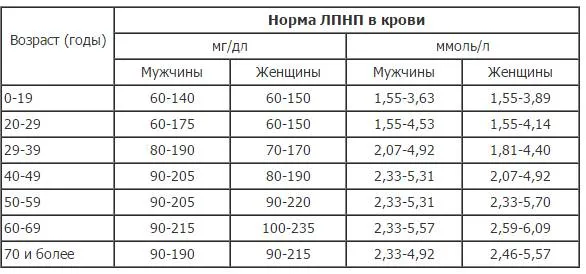
There is no exact indicator of low-density fat, but the indicator should be no more than 2.5 mmol.
If it is exceeded, then reconsider your diet and lifestyle. People at risk of cardiovascular diseases, strokes - this figure should not exceed 1.6 mmol.
Formula for calculating the Atherogenic Index
KA = (total cholesterol - HDL) / HDL
Normal indicators of the atherogenic index: in young people, the permissible norm is about 2.8; other people over 30 – 3-3.5; In patients predisposed to the development of atherosclerosis and its acute form, the coefficient varies from 4 to 7 units.
Normal triglycerides
The level of glycerol and its derivatives depends on the age of the patient.
Until recently, this figure was in the region of 1.7 to 2.26 mmol/l, for people at risk of cardiovascular disease this was the norm. Now the probability of atherosclerosis and heart attack may be at 1.13 mmol/l
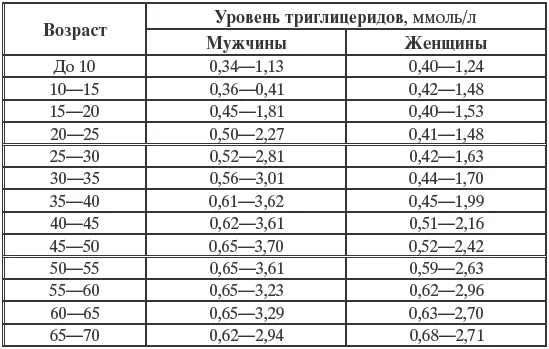
- For men 25-30 years old – 0.52-2.81
- Women 25-30 years old – 0.42-1.63
Reasons when triglyceride levels are low may be:
- Liver diseases
- Lungs
- Diabetes
- Hypertension
- Hepatitis
- Cirrhosis of the liver
Elevated triglyceride levels with:
- Coronary heart disease.
Blood cholesterol levels in women - table (by age)
For several years now we have been hearing about the health risks of cholesterol. However, in fact, it is not only a “negative hero”, but also a very useful (moreover, a VITALLY IMPORTANT element!) for our health. Only “everything needs moderation!”, as the ancient doctors and thinkers said. Including the “measure” of cholesterol in all its fractions. That is why, (just below) we have presented a table: “blood cholesterol norms in women (by age: after 30, 35, 40, 45, 50, 55, 60, 65, 70 years). Based on the results of which, you can easily understand: is everything okay (normal)!? There are also small comments (by age), because... More detailed information is available in other articles (on our website).
But first, would you agree, it’s worth understanding the general concepts (in the most accessible form)? And, first of all, what do the “strange” letters and numbers mean in the LIPIDOGRAM (that is, in simple terms, in a special / biochemical “blood test for cholesterol)?
LDL cholesterol (LDL-C)
- this is conditionally “bad”
Cholesterol (Low Density Lipoproteins
/ Low Density Lipoproteins - in the English version), which, during the process of hydrolysis, is formed in the liver from LDL (VERY Low Density Lipoproteins).
It has earned such a “bad” reputation due to its ability to “deposit” directly in the walls of blood vessels ( see video at the bottom of the page, duration: 42 seconds
).
Thus, forming “fatty” cholesterol plaques, which significantly increases the risk of developing atherosclerosis . In general, simply put, the less it is in the blood, the better it will be for us! Although, it helps our body fight particularly dangerous bacterial toxins.
Cholesterol - the norm in women by age and diet
Cholesterol is one of the substances found in the human body. This fat-like substance is considered harmful to health and can actually cause serious illness.
An effective remedy for reducing “bad cholesterol” is Lecithin . It plays a vital role in the life of the human body and is necessary for the prevention and treatment of atherosclerosis, diseases of the digestive organs, diseases of the brain and nervous system, as well as the cardiovascular system.
If it is deficient, the body does not process vitamins A, D, E, K. Lecithin normalizes or significantly reduces cholesterol levels in the blood. It is recommended to take Lecithin for active chronic hepatitis, and it also alleviates the condition of psoriasis.
Natural Sunflower Lecithin can be ordered on iHerb.
But there is a certain norm of cholesterol in women, which is necessary for the functioning of the body. This complex fatty alcohol, found in the membranes of all living cells, is involved in the construction and functioning of cells, in the synthesis of substances necessary for the body, for example, sex hormones.
The level of cholesterol in the blood varies greatly depending on gender, age and health characteristics of a person. For example, young men have more cholesterol than young women, and after 50 years these indicators change and women have a higher level of fatty compounds than men at this age.
Cholesterol in the correct form and in moderate quantities is not dangerous and is easily transported between different organs and tissues. There is a misconception that the level of cholesterol in a woman’s body depends only on the food she eats.
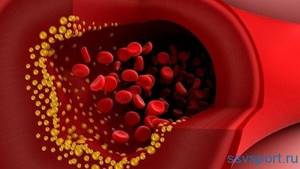
In fact, this substance is formed in the liver in an amount of more than 80%, and only about 20% enters the body with food. Although proper nutrition also plays an important role in case of high blood cholesterol.
Cholesterol - the norm in women by age: types of cholesterol
Cholesterol is transported throughout the body using lipoproteins. There are two types of lipoproteins: low-density lipoprotein is called HDL, and high-density lipoprotein is called LDL.
The latter lipoprotein is considered “bad cholesterol”. This type of lipoprotein accumulates in the body in the arteries, which increases the risk of cardiovascular disease. Therefore, high LDL levels are a cause for concern. Dangerous “bad” cholesterol comes in the form of larger particles. Circulating in the blood, they settle in the vessels, which leads to their blockage and atherosclerosis.
“Good” cholesterol, or its correct form, is the combination of this substance with special high-density protein-fat particles - HDL lipoproteins, also called alpha cholesterol. In turn, “good cholesterol” is involved in transporting cholesterol from the body back to the liver, and then removing it from your body.
The recommended level of LDL cholesterol is higher for women than for men. If this compound is contained within the normal range in women by age, then all processes in the body proceed correctly, which has a positive effect on overall well-being. Below we will look at the cholesterol level in women after 50 years.
What should be the normal level of cholesterol in the blood of women and what are the dangers of its deviations?
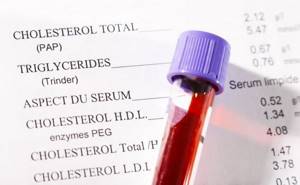
It is known that fats are necessary for the female body to function normally, but many still have a negative attitude towards cholesterol, because it is associated with the risk of developing atherosclerosis and other cardiovascular diseases. In reality, everything is much more complicated: since cholesterol is a collective concept, it needs to be considered comprehensively, because depending on its form, it affects the condition of blood vessels differently.
What does an HDL test show?
Cardiovascular diseases are the leading cause of death worldwide. The discovery of the mechanism of HDL modification has made it possible to use new opportunities for the diagnosis and treatment of atherosclerosis.
Assessing the properties of high-density lipoproteins helps predict the risk of developing this pathology associated with the deposition of cholesterol in the lumen of blood vessels. Currently, the main direction in the treatment of atherosclerosis is the development of pharmacological agents that normalize the function of HDL and increase their concentration in human blood.
The level of high-density lipoproteins, as well as other data on concomitant diseases, age and gender, blood pressure, and the presence of bad habits, are taken into account by doctors to assess the individual risk of developing serious complications of cardiovascular pathologies: myocardial infarction and stroke.
For these purposes, the SCORE (Systematic COronary Risk Evaluation) scale was developed abroad, which was based on studies conducted in 12 European countries with a total coverage of more than 200 thousand patients.
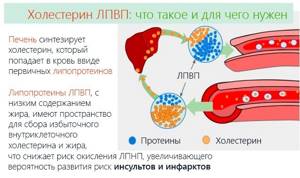
HDL, the norm for women according to age is discussed in the article, has a whole range of atheroprotective properties (antioxidant, anti-inflammatory, antithrombotic). These substances are part of the innate immune system. With systemic inflammation in the human body, they can lose their original characteristics.
A low HDL level signals a high risk of developing atherosclerosis and cardiovascular pathologies. It is often combined with hypertriglyceridemia (increased levels of triglycerides in the blood), insulin resistance, diabetes mellitus and other metabolic disorders.
Good (HDL) and bad (LDL): what values should you pay attention to?
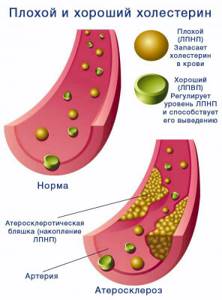
Total cholesterol (TC, OXC) – the entire volume of lipid in the blood, is divided into several fractions:
- “bad” cholesterol (LDL, LDL) are low-density lipoproteins, which, in the presence of provoking factors, “lose” a certain amount of free cholesterol, which settles on the inner lining of the arteries;
- “good” cholesterol (HDL, HDL) are high-density lipoproteins that have the opposite effect, i.e. they cleanse blood vessels, capturing cholesterol accumulated in them and removing it with bile.
When diagnosing a persistent excess of cholesterol levels (hypercholesterolemia), the main attention is paid to the concentration of LDL, as the most atherogenic fraction, but the most accurate information is provided by the ratio of LDL (70–75%) and HDL (25–30%), since an increase in one indicator can turn out to be just an accident.
Blood cholesterol levels in women by age: table
All people need a full spectrum of lipoproteins, but only in a certain amount, which depends on the characteristics of a particular organism.
Cholesterol standards for women for each age are shown in the table of average statistical indicators:
| Age, years | Optimal cholesterol concentration in blood serum, mmol/l | ||
| “good” cholesterol (HDL) | “bad” cholesterol (LDL) | general cholesterol (TC) | |
| 02–04 | —— | —— | 2,90–5,18 |
| 05–09 | 0,93–1,89 | 1,76–3,63 | 2,26–5,30 |
| 09–14 | 0,96–1,81 | 1,76–3,52 | 3,21–5,20 |
| 15–19 | 0,91–1,91 | 1,53–3,55 | 3,08–5,18 |
| 20–24 | 0,85–2,04 | 1,48–4,12 | 3,16–5,59 |
| 25–29 | 0,96–2,15 | 1,84–4,25 | 3,32–5,75 |
| 30–34 | 0,93–1,99 | 1,81–4,04 | 3,37–5,96 |
| 35–39 | 0,88–2,12 | 1,94–4,45 | 3,63–6,27 |
| 40–44 | 0,88–2,28 | 1,92–4,51 | 3,81–6,53 |
| 45–49 | 0,88–2,25 | 2,05–4,82 | 3,94–6,86 |
| 50–54 | 0,96–2,38 | 2,28–5,21 | 4,20–7,38 |
| 55–59 | 0,96–2,35 | 2,31–5,44 | 4,45–7,77 |
| 60–64 | 0,98–2,38 | 2,59–5,80 | 4,45–7,69 |
| 65–69 | 0,91–2,48 | 2,38–5,72 | 4,43–7,85 |
| 70+… | 0,85–2,38 | 2,49–5,34 | 4,48–7,25 |
Young girls (14–30 years old) usually have low levels - 3.21–5.75 mmol/l, since their reproductive system actively uses lipids to reproduce sex hormones. Later (30–40 years), when the metabolic rate decreases and the body is no longer able to remove exogenous cholesterol at the same rate, the safe level increases slightly – 3.37–6.27 mmol/l.
In adulthood (40–50 years), reproductive function declines, i.e., the production of estrogens, which stabilize lipid concentrations, decreases, and accordingly their norm becomes even higher – 3.81–6.86 mmol/l. Upon the onset of menopause (50–60 years), due to the cessation of ovarian function, most of the cholesterol remains completely unclaimed, which increases its value – 4.20–7.69 mmol/l
In older women (60–70 years old), sufficient accumulation of harmful substances, as well as chronic diseases, inevitably lead to an increase in cholesterol in the blood - 4.45–7.25 mmol/l and its level should be approximately this constant.
Changes in indicator during pregnancy
The normal level of cholesterol in the blood of women carrying a child may differ from the standard by 1.5–2 times, which is due to its high need for the synthesis of the “pregnancy hormone” - progesterone. In addition, it is required for the formation of a new organ - the placenta and vitamin D, which promotes the absorption of calcium, which the baby’s body needs.
In pregnant women, acceptable cholesterol concentrations also depend on age:
| Age, years | Normal level of total cholesterol in the blood in the 2nd–3rd trimester, mmol/l |
| 16–19 | 6,16–10,36 |
| 20–24 | 6,27–11,21 |
| 25–29 | 6,64–11,40 |
| 30–34 | 6,73–11,94 |
| 35–39 | 7,26–12,69 |
| 40–45 | 7,62–13,85 |
After childbirth, indicators, as a rule, are restored, but sometimes they can persist until the end of the lactation period - this is an acceptable variant of the physiological norm.
A cause for concern is when cholesterol levels exceed the normal level by more than 2–2.5 times: in this case, it poses a threat both to the health of the woman herself and to the development of the fetus.
Table of normal cholesterol levels in women
There are certain standards within which all substances in the body must be contained. Cholesterol is paired with proteins. Another substance is called cholesterol. It is divided into two types based on density. Low is considered “bad” (LDL cholesterol). It forms plaques on the walls of blood vessels. High density is considered “good”. It protects the arteries.
A substance with low density is dangerous for humans, since it consists of larger molecules that easily clog blood vessels. Low cholesterol poses the greatest harm to the body; the norm for women varies slightly by age and the value may be less than 5 mmol/l. The substance for analysis is taken on an empty stomach. Total cholesterol is divided into three content categories (in mmol/l):
- optimal (less than 5.2),
- maximum (from 5.21 to 6.2),
- elevated (more than 6.2).
The cholesterol level also depends on the woman’s age. More accurate values are contained in the table in this article. The general norm for cholesterol levels for women is: “good” - from 0.87 to 2.28, “bad” - from 1.93 to 4.52. A substance with a good density is produced by the body itself, and a substance with a low density is supplied with food.
Cholesterol has a separate normal value for pregnant women. In a healthy and young body, most often the level does not exceed the normal value. In the second and third trimester, cholesterol can increase by 1.5 - 2 times. The exact value depends on the woman's age. If you have high cholesterol, you must follow a diet. In this case, the value will quickly return to normal.

What is the danger of exceeding the norm and what are the reasons for deviations?
The cause of hypercholesterolemia can be an internal malfunction in the body or an external influence on it:
- genetic abnormalities - alipoproteinemia, endogenous hyperlipidemia, polygenic and hereditary hypercholesterolemia;
- disruption of the endocrine system - hypofunction of the thyroid gland (hypothyroidism), diabetes mellitus type 1 and 2;
- diseases of the reproductive organs - polycystic ovary syndrome (PCOS) and uterine fibroids;
- kidney and liver diseases - hepatitis, cirrhosis, obstructive jaundice, pyelonephritis, renal failure;
- unhealthy lifestyle – unbalanced diet, low physical activity, excess weight, systematic lack of sleep and stress;
- taking certain medications - beta-blockers, thiazide diuretics, steroids and anticoagulants.
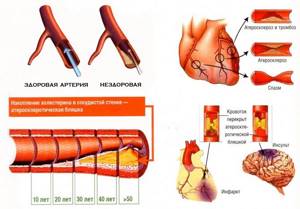
The formation of deposits on the walls of blood vessels due to increased levels of cholesterol in the blood.
Reasons for deviations from the norm
Test results are not the only criterion for determining atherosclerosis and other cardiovascular diseases. An accurate diagnosis can only be established by the attending physician based on cumulative data obtained from other types of laboratory and instrumental studies, as well as information from the patient’s medical history.
A decrease or increase in HDL is observed in hereditary diseases, metabolic disorders and other pathologies listed below. When the underlying cause is eliminated, the level of “good” cholesterol is restored. In some people, low HDL levels do not correlate with a high risk of atherosclerosis, but are an individual characteristic of the body.
Promotion
An increase in lipoproteins in the blood serum occurs in the following cases:
- Liver diseases:
- primary biliary cirrhosis;
- chronic hepatitis in the active stage;
- obstructive jaundice;
- acute poisoning.
- Hereditary increase in HDL levels (hereditary hypercholesterolemia types IA and IIB).
Demotion
A decrease in HDL levels occurs in the following diseases and conditions:
- Kidney pathologies:
- chronic renal failure;
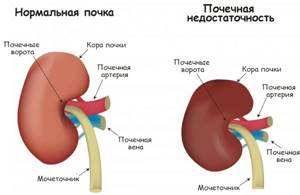
- nephrotic syndrome, in which the patient experiences disturbances in protein-lipid metabolism and edema.
- Cholestasis (stagnation of bile).
- Hereditary pathologies – primary hypo-a-lipoproteinemia.
- Metabolic disorders:
- obesity;
- hypertriglyceridemia;
- diabetes mellitus in the stage of decompensation.
- Bad habits:
- alcoholism;
- smoking.
- General exhaustion of the body as a result of infectious and other serious diseases.
- Carbohydrate diet.
Characteristic signs of a violation
The initial stages of hypercholesterolemia are not accompanied by any external changes, so it can be visually detected only when obvious symptoms of atherosclerosis begin to appear:
- discomfort, pain in the heart and hypochondrium, unstable heart rhythm;
- increased blood pressure (hypertension), dizziness, blurred vision;
- swelling, pain, numbness, impaired thermoregulation (chillness) of the hands and feet;
- chronic fatigue, weakness, drowsiness or, conversely, insomnia;
- bad breath (halitosis), upset bowel movements (diarrhea), or constipation
Sometimes lipid deposits form small rounded planes (xanthomas) on the face, hands and other parts of the body (less commonly), as well as arcs or rims (gerontoxons) of light gray color on the outer border of the iris.
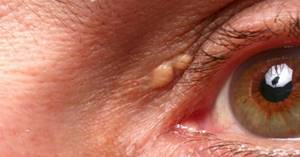
Xanthomas as a consequence of the development of atherosclerosis.
How to reduce the indicator to normal values?
It is necessary to reduce the concentration of cholesterol in the blood in a comprehensive manner: for this, a diet is combined with physical activity and, if necessary, medications are prescribed.
If hypercholesterolemia is a consequence of another disease, then it must initially be treated or controlled if it is incurable.
Nutrition and diet
To reduce blood cholesterol levels, a special hypocholesterol diet (table) No. 10, developed by M. I. Pevzner, is well suited:
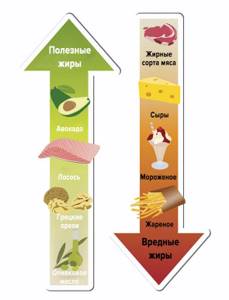
Limiting high-cholesterol foods - fatty meat, poultry with skin, lard, offal and whole milk.
- Minimization of industrially produced products - sausages, canned food, sauces, spreads, confectionery products and fast food.
- Cooking any dishes only by steaming, boiling or baking (frying and smoking is prohibited!).
- Replacing animal products with plant products - fruits, vegetables, herbs, root vegetables, legumes, including soybeans, cereals and grain bread.
- Consumption of unsaturated fatty acids – seafood, fish, unrefined vegetable oils, seeds and nuts.
- stop smoking and drinking alcohol;
- do not drink caffeinated drinks;
- avoid stress and conflicts as much as possible;
- sleep enough time (8 hours);
- normalize and maintain body weight;
- regularly engage in adequate exercise.
The entire daily diet is divided into 5–6 small meals. For a snack, you can eat, for example, an apple, orange, cucumber or a glass of low-fat yogurt.
Lifestyle

How to increase good cholesterol levels.
An unhealthy lifestyle negatively affects the permeability and elasticity of blood vessels, which provokes an additional increase in cholesterol, so in case of hypercholesterolemia it is recommended to change it:
Aerobic exercises are good for physical activity: swimming, intense walking, running, cardio exercises and rhythmic dancing. During exercise, it is important to ensure that the heart rate does not increase by more than 80% of the usual frequency.
Medicines in tablet form
If the cholesterol level greatly exceeds the permissible limit and it cannot be reduced for a long time by non-drug methods, then patients are prescribed lipid-lowering drugs:
statins (atorvastatin, rosuvastatin, simvastatin) – inhibit the production of enzymes necessary for the process of cholesterol synthesis;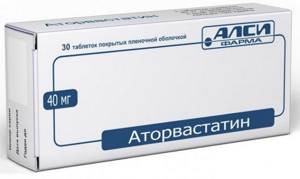
- fibrates (fenofibrate, ciprofibrate) – bind to bile acid and reduce the active production of cholesterol by the liver;
- nicotinic acid (aka niacin, vitamin PP and B3) – inhibits the absorption of fats, reducing blood viscosity, which improves overall blood flow.
Also, if the diet does not have enough Omega-3 polyunsaturated fatty acids (PUFAs) (20-25%), then the doctor may recommend taking them in the form of drugs - Omacor, Norvesol, Vitrum Cardio.
How long does the treatment last and when will the first results appear?
A well-chosen treatment regimen quickly produces results: the first effect is noticeable within 1.5–2 weeks after starting medication, and after 1 month it is maximally evident and is maintained throughout the entire therapy. How long it will last depends on the severity of the situation: usually 1 course lasts 45–60 days, after which the doctor may reduce the dosage or stop taking the medication.
Sometimes it is not possible to achieve stabilization of lipid metabolism, and then to maintain normal cholesterol levels you need to take lipid-lowering drugs for life.
How often do you need to donate blood for biochemical analysis?
For relatively healthy young women, it is enough to determine the lipid profile (lipidogram) once every 2–4 years, after the onset of menopause, more often - once a year. When planning conception and pregnancy, it is advisable to monitor cholesterol levels every 3 months.
In some cases, in order to obtain correct data, it is necessary to donate blood for analysis again, since the result is influenced by many factors: the place where the material was taken (from a finger or from a vein), on an empty stomach (on an empty stomach) or after a meal, whether the laboratory has changed, etc. d.
What does it mean if total cholesterol is elevated?
Important: a single deviation from the reference values has no diagnostic significance and can be explained by physiological reasons. The analysis must be retaken after 1 month at least twice, after which the final diagnosis is made.
Causes of increased concentration of total cholesterol in the blood:
- genetic predisposition – family history of hypercholesterolemia;
- eating large amounts of food rich in fats;
- chronic liver pathologies (cirrhosis, hepatitis), which provoke bile stagnation;
- kidney infection;
- diabetes;
- malignant neoplasms of the prostate or pancreas;
- lack of thyroid hormones;
- alcoholism.
Depending on the results of the study, the patient is assigned to one of the groups identified according to the degree of risk of developing pathologies of the cardiovascular system:
- normal values (up to 5.6 mmol/l) – low risk;
- at the upper limit of normal (up to 6.7 mmol/l) – average risk;
- above normal (more than 6.7 mmol/l) – high risk.
Patients at medium and high risk are prescribed additional laboratory diagnostics - determination of the lipid profile (lipidogram), which allows us to clarify the exact concentration of HDL and LDL.
Elevated cholesterol levels in children are explained by similar reasons as in adults: heredity, overeating and excess weight. Greater attention should be paid to creating a menu for children, while avoiding foods with excess fat and sugar.
Is an extremely low score good or bad?
In women, cholesterol is often below normal due to taking progestin-containing drugs, following a plant-based diet, or fasting. Such hypocholesterolemia is not dangerous - it is treated by selecting compensating drugs and eating foods rich in fat.
If there are no external factors, then there may be hidden negative processes in the body: liver damage, general intoxication or local infection.
It is important to understand that lipid metabolism disorders manifest themselves gradually, i.e., high or low cholesterol levels will not affect health immediately, but if measures are not taken in a timely manner, it will affect not only well-being, but also further capacity.
source
Cholesterol norms for women by age
The level of cholesterol in women by age in the blood changes during menopause, when the body is actively restructuring; before this process, the level of cholesterol is usually stable throughout the entire period of a woman’s life. During this period, increased cholesterol levels are observed in women.
It is not uncommon for an inexperienced doctor to not accurately assess the test result, which leads to an incorrect diagnosis. The test results and cholesterol can be influenced not only by the patient’s gender and age, but also by a number of other conditions and factors.


